












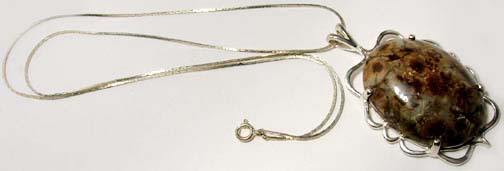
Antique Nineteenth Century Genuine Natural Ninty-Two Carat Hand Crafted/Polished Siberian “Coral” Agate Semi-Precious Gemstone. Mounted into high quality solid sterling silver pendant (not cheap silver plated).

CLASSIFICATION: Polished Agate Cabochon Semi-Precious Gemstone. Chain and pendant setting contemporary.
ORIGIN: Russia; 19th Century; Siberian Southern Urals near Yekaterinburg.
SIZE: Length: 40mm. Width: 30mm. Depth (Thickness): 8mm. Measurements approximate.
WEIGHT: 92.15 carats.
NOTE: Default chain is silver electroplate 16, 18, 20 or 24 inch (provided free). Sterling silver chains are also available in lengths from 16 to 24 inches. We also have available handcrafted, high-quality Greek black leather cords.
NOTE: This same setting is also available in 14kt solid gold. If you would prefer a different setting style, odds are we have many different setting styles available which would fit this stone which could be substituted for no or very little additional cost. 14kt solid gold settings and 14kt gold fill (5% gold over 95% silver) are also available. Write us for pictures and prices.
NOTE: If you would like only the gemstone, and not the setting, we can dismount the gemstone and offer you the gemstone without the setting. Just let us know, and yes, we’ll discount the price by the cost of the setting.

DETAIL: Agate is named after its ancient source, the Achates River in Sicily. In the ancient world Persian magicians were believed to possess the power to divert storms through the use of agate talismans. Agate was also extremely popular for use in jewelry in ancient Sumeria, and when worn as a Talisman it was believed had the power to quench thirst and to protect the wearer from fevers. Ancient Persians also believed that agate would confer eloquence upon the wearer. The ancient Persians (as well as other ancient Near Eastern cultures) also used agate as an antidote to fevers by placing the agate in the mouth. It was said to relieve thirst and reduce body temperature. The ancient Babylonians used red agate to treat insect bites and stings, green agate to treat eye infections, and black agate (onyx) to protect women from disease. Agate talismans were worn in the Ancient Middle East to keep the blood healthy.
Celebrating this cultural legacy here’s a very nice quality nineteenth century antique hand crafted/shaped/polished agate semi-precious gemstone from the Southern Urals Region of Siberia (Russia). Yes! This is a natural gemstone, colored only by mother nature, it is not dyed. The variety is most often referred to as “agatized fossil coral”. Fossil coral is a natural stone that is formed when ancient coral is gradually replaced with agate, just as petrified wood starts as wood but eventually becomes stone. The proper name for this material is agatized coral or agatized fossil coral. The fossilized coral typically appears as small flower-like patterns in the stone. Agatized fossil coral can exhibit a wide range of natural colors, ranging from white and pink to brown, gray, black, yellow and red.
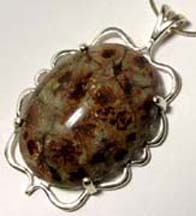
Corals are among the most colorful animals in the sea. Most corals live in warm, shallow, tropical seas and feed on plankton. Corals are marine animals with a sac-like body, mouth, tentacles and skeleton. It is the skeleton that survives in the fossil record. The oldest fossil corals are from the Ordovican period, over 450 million years ago. The gemstone was produced in the late nineteenth or early twentieth century by Russian artisans famed for centuries for the elaborate jewelry produced using precious and semi-precious gemstones mined in the fabled Southern Ural Mountains of Siberia. Agate has been popularly used through recorded history for the production of jewelry, beads, and amulets due to the vibrant rainbow of colors agate naturally occurs in. Agate amulets produced by Stone Age man in France has been discovered, dating the known use of agate back to approximately 20,000 B.C.
Though the classical source of agate for the ancient Mediterranean world was Sicily, the Southern Urals of Siberia have been producing agate gemstones for use in Russian jewelry for at least 1,000 years. And Russia was famous for its elaborate jewelry through the Medieval, Renaissance, and Victorian worlds. The setting is of contemporary origin. It is a high quality setting manufactured by one of the USA’s leading semi-custom mount producers. It is constructed of solid sterling silver, and can be reset into 14kt gold if requested, and there are also many other setting styles available upon request. If you would like to see them, email us and we will reply with pictures of other available setting styles. The default chain is silver electroplated 24 inch. However we do have solid sterling silver (as well as 14kt gold and gold fill) chains available in lengths between 16 and 24 inches available upon request. We also have available high quality (solid, not formed) handcrafted genuine Greek leather cord with either sterling silver or bronze/brass fasteners.

As might be expected under magnification the gemstone shows the unmistakable, hallmark characteristics of having been hand crafted. The coarseness of the 19th century finish is considered desirable to most gemstone aficionados, and is not considered a detriment, or detract from the value of a gemstone. These characteristics are not only expected of hand-finished gemstones, many believe that such antique hand-crafted gemstones possess much greater character and appeal than today's mass-produced, laser-cut gemstones. Unlike today’s computer controlled machine produced gemstones that approach flawlessness in a perfect finish, the cut and finish of an antique, handcrafted gemstone such as this is the legacy of an artisan who lived two centuries ago.
Handcrafted though it may be the gemstone has great luster and character, but that is not to imply that it is absolutely flawless. True, the blemishes it possesses are virtually invisible to the naked eye, and to the view of the casual admirer the gemstone is indeed seemingly without blemish. However in the accompanying photo enlargements you might be able to discern a few minute blemishes as well as occasional irregularities in the cut and finish. Naturally much the same may said about almost any natural gemstone. Most absolutely flawless gemstones will upon close examination be revealed to be synthetic. Furthermore these characteristics are not only expected of hand-finished gemstones, you must also consider that two centuries ago the mining techniques even possible then, let alone in practice, did not allow the ultra deep mining operations which are so commonplace today.

HISTORY OF AGATE: Agate is named after its ancient source, the Achates River in Sicily, now known as the Drillo River, which remains a major source of this gemstone. The gemstone was so named by the 4th century B.C. ancient Greek Philosopher/Naturalist Theophrastus, who “discovered” the stone along the shore line of the river (there’s a dissenting opinion that the word agate is derived from the Greek word "agateес" – meaning happy). The Greeks used agate for making jewelry and beads. Ancient Greek mariners wore amulets of agate to protect against the perils of the sea. The Ancient Greeks also used agate to relieve stomach pains and diarrhea.
However agate had already been used for by man for decorative and amuletic purposes for thousands of years prior to the ancient Greeks, first by Stone Age man in France around 25,000 B.C. Archaeological discoveries demonstrate that the ancient Egyptians used agate well prior to 3,000 B.C. for talismans, amulets, seals, rings and vessels. In the Ptolemaic Period (fourth century B.C. to first century A.D.) the ancient Egyptians carved agate carved into scarabs. The ancient Egyptians believed that gray agate when worn around the neck would protect against and heal stiffness of the neck.
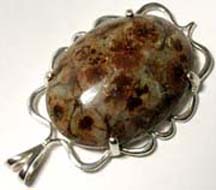
Agate was also extremely popular for use in jewelry in ancient Sumer, and agate was amongst the archaeological artifacts excavated at the Knossos site on Crete evidencing its use by the Bronze Age Minoan culture (about 1,800 B.C.). Persian magicians were believed to possess the power to divert storms through the use of agate talismans. Ancient Persians also believed that agate would confer eloquence upon the wearer. The ancient Persians (as well as other ancient Near Eastern cultures) also used agate as an antidote to fevers by placing the agate in the mouth. It was said to relieve thirst and reduce body temperature.
The ancient Babylonians used red agate to treat insect bites and stings, green agate to treat eye infections, and black agate (onyx) to protect women from disease. Agate talismans were worn in the Ancient Middle East to keep the blood healthy. In ancient Asia, agates were used by seers and magicians to see into the future. Agate was highly valued as a talisman or amulet in many other ancient cultures. It was said to quench thirst and protect from fevers. Another widespread belief in the ancient world was that wearing agate as a talisman would render the wearer invisible, thereby protecting the wearer from danger. Athletes throughout the ancient world wore agate amulets with the belief that agate would give them extra energy during competition and help them recover their strength afterwards.

Agate was also worn by various ancient cultures as protection against drowning, falling, mischievous fairies and poison, and was also believed an effective talisman to protect young children from harm. Farmers in many ancient civilizations (including the Romans) wore agate talismans to ensure a good harvest. The Romans, as well as the ancient Greeks, made extensive use of agate in their production of cameos and intaglio seals (as in signet rings). Moss agate, according to the Romans, had a divine power and an agate stone was used to grind ingredients for lotions and other ointments on, believing it would improve one's eyesight and/or disposition.
A famous collection of four thousand agate bowls that was accumulated by Mithradates, king of Pontus (Hellenic Turkey)Hellenic Turkey) is illustrative of the high value the ancient world had for agate. Agate bowls were also popular in the Byzantine Empire. Collecting agate bowls became common among European royalty during the Renaissance and many museums in Europe, including the Louvre, have spectacular examples. Early Celts in Britain used the gem to prevent skin disease, and in Celtic mythology orange agate was believed to be a powerful protection against Dragons. The Vikings and Saxons used agate to find lost items by ax and stone, a method of divination known as “axinomancy”.
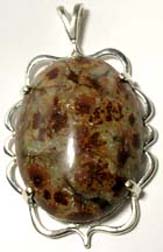
In that ceremony a double-headed ax would be made red-hot and then the shaft pushed into a hole. A round agate pebble would then be placed on the upright ax head. If the pebble stayed on top of the ax, the questioner had to look elsewhere for the lost item. If the pebble fell to the ground, the questioner had to follow the direction of the rolling stone to find the missing item. During the Roman wars with the Gauls (in the first century B.C.), agate deposits were discovered along the Nahe river (a tributary to the Rhine) in Germany. The gem-cutting facilities set up there by the Romans survived until present day and, although the deposits are now depleted, the city of Idar-Oberstein on the Nahe river is still the major lapidary center of Europe.
Particularly from the 16th century onwards, huge quantities of cameos were cut from agate where layers of different colors occurred within the stone. The background material was cut away, leaving the cameo design in relief. In the Middle Ages and through to the Renaissance agate was worn as a talisman in the belief it could prevent harm from thunder and lightening, sorcery, poison, drunkenness and demonic possession. Medieval shamans and sorcerers believed that agate allow them to divine the truth. Agate was also believed to remove curses and spells, and to help eliminate bad luck. In Renaissance Europe, agate was believed to have a calming effect during times of stress and to give the wearer strength and courage. Renaissance-era artists and writers wore agate in the belief it would enhance creativity.
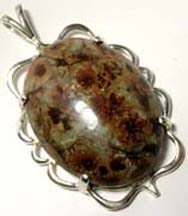
Wearing agate was also believed to improve vitality and physical strength, relieve headache pain, ensure marital and romantic fidelity, stimulate the intellect, and suppress anger. Agate was prized in Czarist Russia as a stone of long life, good health and prosperity. Agate is a variety of chalcedony quartz composed of colorful microscopic crystals of quartz occurring in bands of varying color and transparency. Most agates start as gas bubble cavities in eruptive rocks or ancient lava. Silica laden water seeps into the bubbles and coagulates to a silica gel, eventually crystallizing as quartz.
Agate is found in a wide variety of patterns and beautiful colors, and can be transparent to opaque. Many fossils (such as petrified wood, petrified coral, and even dinosaur bones) are agatized material where the original organic substance has been replaced by agate while retaining the original structure. The primary sources of agate today are Brazil, Uruguay, China, India, Madagascar, Mexico, the Ural Mountains of Russia, and the USA.

Throughout the history of the ancient world, gemstones were believed capable of curing illness, possessed of valuable metaphysical properties, and to provide protection. Found in Egypt dated 1500 B. C., the "Papyrus Ebers" offered one of most complete therapeutic manuscripts containing prescriptions using gemstones and minerals. Gemstones were not only valued for their medicinal and protective properties, but also for educational and spiritual enhancement. In the ancient world it was believed that wearing agate made a person agreeable, happy, and cautious yet brave. Ancient cultures used it as a talisman as it was believed to bestow on the wearer protection against all dangers.
White agate was used as a cure for insomnia and guaranteed pleasant dreams. Agate was also believed to improve memory and concentration, increase stamina and encourage honesty, as well as aiding wearers to remain calm and focused. Contemporary practitioners attribute agate with fostering the ability to discover one's natural talents, enhancing analytical ability, and improving perceptiveness. It is believed to create a healthy balance between the physical, emotional and spiritual state of the wearer. Agate is reported to be an aid in overcoming fears and loneliness.

It is reputed to help the wearer view themselves with more clarity and view the world with a broader perspective. It is claimed to eliminate and cleanse “negative energies” from the body, and is thought to stimulate fertility and to be effective in treating bone marrow ailments and allergies. Due to the association with precision, agates are touted as useful talismans for accountants and bankers. And as in the distant past, agate is still considered an effective talisman which will increase wealth, good luck, long life, courage and strength; and to help protect and heal the wearer.
Domestic shipping (insured first class mail) is included in the price shown. Domestic shipping also includes USPS Delivery Confirmation (you might be able to update the status of your shipment on-line at the USPS Web Site). Canadian shipments are an extra $17.99 for Insured Air Mail; International shipments are an extra $21.99 for Air Mail (and generally are NOT tracked; trackable shipments are EXTRA). ADDITIONAL PURCHASES do receive a VERY LARGE discount, typically about $5 per item so as to reward you for the economies of combined shipping/insurance costs. Your purchase will ordinarily be shipped within 48 hours of payment. We package as well as anyone in the business, with lots of protective padding and containers.

We do NOT recommend uninsured shipments, and expressly disclaim any responsibility for the loss of an uninsured shipment. Unfortunately the contents of parcels are easily “lost” or misdelivered by postal employees – even in the USA. If you intend to pay via PayPal, please be aware that PayPal Protection Policies REQUIRE insured, trackable shipments, which is INCLUDED in our price. International tracking is at additional cost. We do offer U.S. Postal Service Priority Mail, Registered Mail, and Express Mail for both international and domestic shipments, as well United Parcel Service (UPS) and Federal Express (Fed-Ex). Please ask for a rate quotation. We will accept whatever payment method you are most comfortable with. If upon receipt of the item you are disappointed for any reason whatever, I offer a no questions asked return policy. Send it back, I will give you a complete refund of the purchase price (less our original shipping costs).
We travel to Russia each year seeking antique gemstones and jewelry from one of the globe’s most prolific gemstone producing and cutting centers, the area between Chelyabinsk and Yekaterinburg, Russia. From all corners of Siberia, as well as from India, Ceylon, Burma and Siam, gemstones have for centuries gone to Yekaterinburg where they have been cut and incorporated into the fabulous jewelry for which the Czars and the royal families of Europe were famous for. My wife grew up and received a university education in the Southern Urals of Russia, just a few hours away from the mountains of Siberia, where alexandrite, diamond, emerald, sapphire, chrysoberyl, topaz, demantoid garnet, and many other rare and precious gemstones are produced. Though perhaps difficult to find in the USA, antique gemstones are commonly unmounted from old, broken settings – the gold reused – the gemstones recut and reset.

Before these gorgeous antique gemstones are recut, we try to acquire the best of them in their original, antique, hand-finished state – most of them centuries old. We believe that the work created by these long-gone master artisans is worth protecting and preserving rather than destroying this heritage of antique gemstones by recutting the original work out of existence. That by preserving their work, in a sense, we are preserving their lives and the legacy they left for modern times. Far better to appreciate their craft than to destroy it with modern cutting. Not everyone agrees – fully 95% or more of the antique gemstones which come into these marketplaces are recut, and the heritage of the past lost. But if you agree with us that the past is worth protecting, and that past lives and the produce of those lives still matters today, consider buying an antique, hand cut, natural gemstone rather than one of the mass-produced machine cut (often synthetic or “lab produced”) gemstones which dominate the market today.
Our interest in the fabulous history of Russian gemstones and the fabulous jewelry of the Czar’s led to further education and contacts in India, Ceylon, and Siam, other ancient centers of gemstone production and finishing. We have a number of “helpers” (family members, friends, and colleagues) in Russia and in India who act as eyes and ears for us year-round, and in reciprocity we donate a portion of our revenues to support educational institutions in Russia and India. Occasionally while in Russia, India, Siam, and Ceylon we will also find such good buys on unique contemporary gemstones and jewelry that we will purchase a few pieces to offer to our customers here in America. These are always offered clearly labeled as contemporary, and not antiques – just to avoid confusion. We can set most any antique gemstone you purchase from us in your choice of styles and metals ranging from rings to pendants to earrings and bracelets; in sterling silver, 14kt solid gold, and 14kt gold fill. When you purchase from us, you can count on quick shipping and careful, secure packaging. We would be happy to provide you with a certificate/guarantee of authenticity for any item you purchase from me. There is a $2 fee for mailing under separate cover. Please see our "ADDITIONAL TERMS OF SALE."

